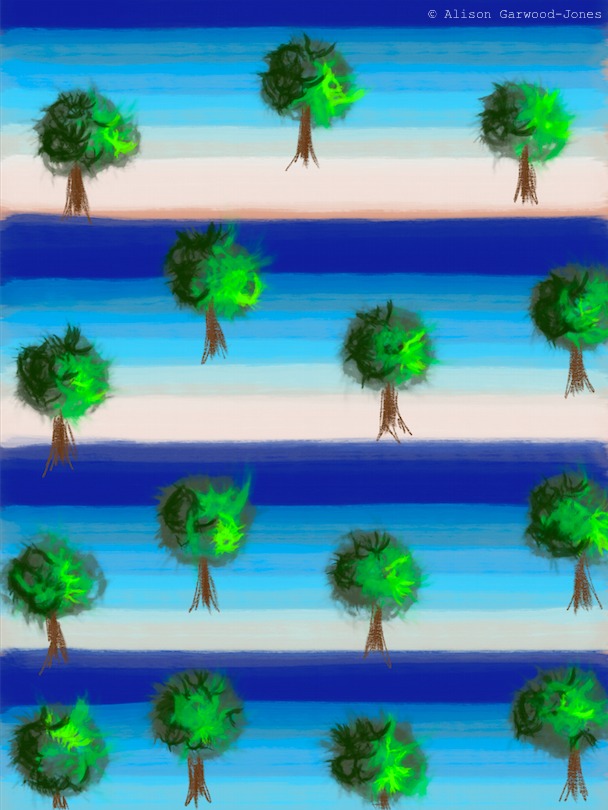
Pattern is a way of re-ordering the world and your emotions into something more beautiful and understandable. It’s why we make art.
It’s why standing under a maple tree and looking up feels so good. I’m looking for a blazing red one this weekend.
October 3, 2014

Pattern is a way of re-ordering the world and your emotions into something more beautiful and understandable. It’s why we make art.
It’s why standing under a maple tree and looking up feels so good. I’m looking for a blazing red one this weekend.
September 28, 2014
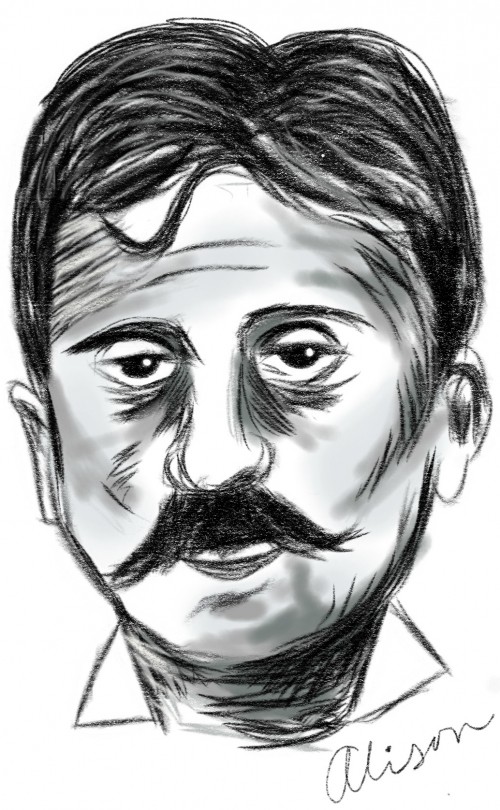
Marcel Proust (above) defined deep reading as the moment when,
“That which is the end of [the author’s] wisdom appears to us as the beginning of ours.” (1906)
Book editor Peter Dimock took it one step further, calling deep reading,
“A time of internal solitary consciousness.” (2010)
Neuroscientist Maryanne Wolf, author of Proust & The Squid, pulled these quotes together in an article for “Nieman Reports” on reading in the digital age.
My friend Jonathan Menon, a fellow writer and loyal reader of this blog, kindly pointed me to this and several key sources I couldn’t find during the writing of my last blog post. Thanks Jonathan!
To recap: in my last blog post, Warp Speed, I tried to describe why I thought a balanced diet of breathless internet search and solitary deep reading (on paper) was essential to my happiness, sanity and the continued good health of my intellectual curiosity. If you feel the same way, I recommend printing out and studying the following articles:
• “Your paper brain and your Kindle brain aren’t the same thing”
(This article is based on a radio interview by Manoush Zomorodi, managing editor and host of WNYC’s New Tech City, with the Washington Post’s Mike Rosenwald. The podcast is embedded in the article)
• “Paper beats computer screens”
• “The Reading Brain in the Digital Age: The Science of Paper versus Screens”
September 12, 2014
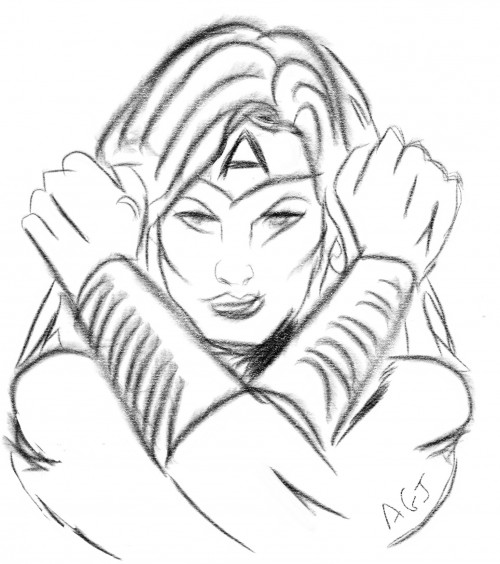
I had a great summer. My blog? Not so much. For three months, it was bombarded by a spam attack so thick and persistent that a team of developers had to put down their swords so they could scratch their heads.
We ended up having to switch commenting platforms (the source of my woes) and settling on Livefyre. Intense Debate is toast.
My thanks to Graham Scott and Danny Brown for their advice. And a very special thank you to Kathryn Barlow of KBarlow Design for clearing out and deflecting all future spam. She was as tenacious as Wonder Woman.
I’ve really missed using this space to write and draw. LinkedIn Publisher is good, but nothing beats posting on real estate you own.
Here’s to a great fall!
Alison
July 31, 2014
When my story pitches for magazines or newspapers tank, it’s usually because:
1. My story idea is lame.
2. The story is good, but my pitch sucks.
3. My editorial connections are too thin.
4. It’s already been done (and, tut tut, I should have known that).
5. It’s a good pitch, but the wrong magazine (and shame on me again for not studying more back issues)
I’m starting to think that none of the above applies to a story idea I’ve been sitting on for months. A producer/documentarian I was introduced to last fall is working on the first ever interactive documentary specifically formatted for the iPad and she wanted some coverage in legacy media. The story is cool, she’s cool, and the whole package has tons of “Now” and “Wow.” But every Canadian and U.S. magazine I pitched either said, “Yeah, maybe” (and never got back to me), or they said nothing at all. Even when I pitched it as an online news feature.
While I was waiting for editors to bite, I followed how the documentary was coming along on social media — it’s debuting in October both on TVO and via a an app — and I think I finally know what’s wrong with my pitch: this story doesn’t need me.
At the same time I was interviewing this talented documentarian in coffee shops and at her home office, she was overseeing a campaign of regular and highly engaging tweets, blogs, video teasers and Facebook posts, leaving no stone unturned about her challenges and incremental victories. I tried to find angles that she hadn’t covered, but the moment I thought of one she wrote about it. So here I was competing with my subject for scoops! Did I resent her? How could I? I loved what she was doing. Showing your progress online is how you gain support, traction and publicity for a project. Holding your cards to your chest and being all secretive until the big reveal is so old school.
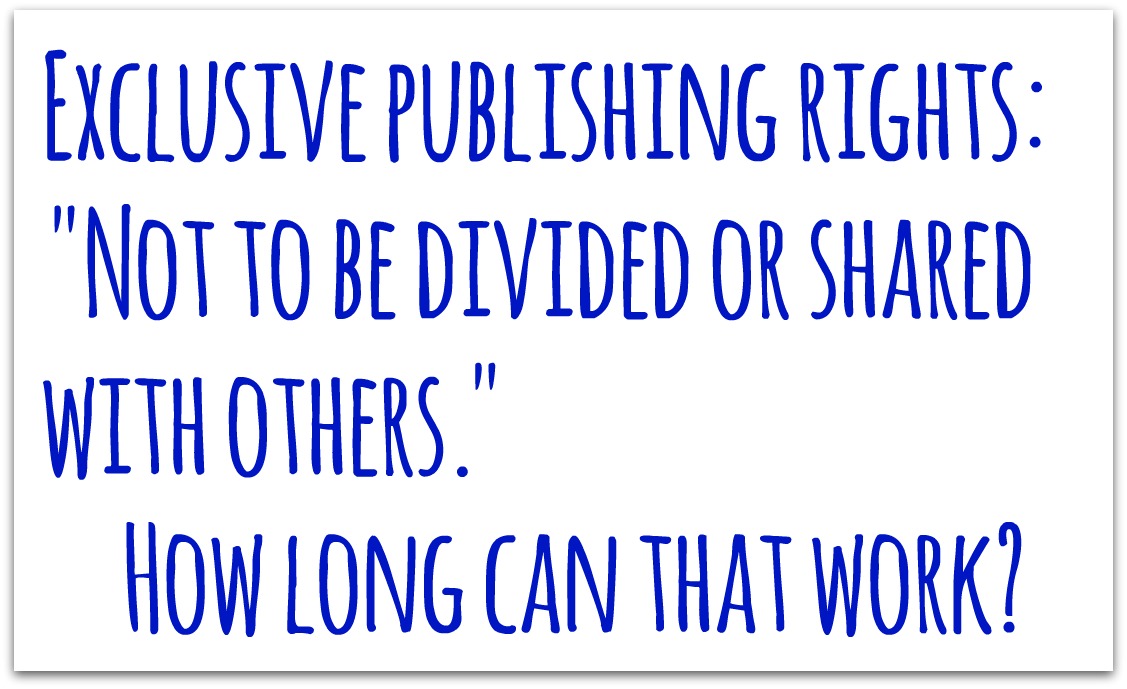
What I’ve learned from this experience is that the challenges facing legacy media aren’t just about advertising and switching to new distribution channels, they’re also about accepting the changing nature of exclusives and the rise of DIY storytelling. For the first time in my career, I knew what it felt like to be the “middleman” between a subject and her work. And we all know the fate of middlemen in the internet age (just ask the music industry). Even PR people have slowed down brokering relationships between journalists and clients. Now they are spending more time coaching brands and startups on how to become the hubs for their own storytelling. Martin Waxman, one of the smartest people I know in communications strategy, said it best,
“These days it’s not enough to be in the news, [startups and brands] need to create, produce and share it. And in order to do that you need to think like a newsroom and amplify stories via social and digital channels.”
I’m still hovering over the “think like a newsroom” part. I met Martin when I was an editor at Elle and he was the head of a PR agency that handled many big-name beauty accounts. I wrote a lot of service-style journalism based on the stories Martin and his team shared with me. Martin abandoned old-style PR, however, the moment he clued in to the power of social media. He adapted to the new landscape way, wa-a-y earlier than most of his colleagues, many of whom were still stubbornly advising clients to stick to a broadcast model of communication — you know, the old “spray and pray” approach. Now Martin is showing brands how to ditch the press release and be their own storytellers. “Start on the inside with a publishing strategy, an approach to content that’s based on what you do better than anyone else,” he told a crowd in Las Vegas last week at the SXSWV2V conference for startups and innovators.
After I left Elle, I my output of service journalism — what today we call “sponsored content” or “brand journalism” — slowed down to nothing as I set my sights on writing more stories about culture, technology, design and human nature. The thrill of writing advertising copy was short-lived for me. That’s why I’ve never had a problem with brands taking over their own storytelling or pulling former journalists into the fold to push out their content, so long as those former journalists only write sponsored content and don’t straddle between that and covering hard news (another post entirely).
But sponsored content isn’t the only storytelling switching hands. Now the stories that are really worth telling, stories of human innovation and stories about people’s struggles and triumphs, are becoming harder to place in magazines as the number of voices telling those stories multiplies.
The predictions were long in coming and I’m finally bumping up against legacy media’s stipulations about lead times, breaking news and exclusives, all of which are totally at odds with the sharing, slicing, dicing, repurposing, in-progress (“Open File”) spirit of online storytelling. I mean, here’s the definition of exclusive publishing rights: “Not to be divided or shared with others.” How long can that work? And are magazines going to keep turning down stories just because the people at the centre of the story have been blogging and tweeting about their work from its inception?
The internet has changed our relationship to the history of ideas. I don’t know how magazines will adapt to that. Maybe it doesn’t matter. I’m in another headspace now: the open, freeform world of blogging and updating.
June 17, 2014
He was all shiny and aquiline when he walked up to the lectern.* His face was pulled tighter than a drum. Jeff Koons, Julian Assange and Andy Warhol stood backstage and watched. Meanwhile, a team of caterers behind some swinging doors at the back were preparing to serve us His Menu of grilled salmon and blueberries. But we couldn’t eat until he had spoken. Our bosses told us to take detailed notes. The PR team putting him up was treating him like a Nobel Laureate. Everything about this felt wrong. Like, 911-wrong. Smart people I liked were pointing to him and nodding. My eyes bore into them as if to say, ‘Are you kidding me?’ They kept silent while the down payments on their mortgages accumulated. He laughed and snarked from the lectern, making us feel bad about ourselves while purporting to make us feel good. This man and his wares belonged in a museum of discarded scams, next to the butt-shaking exercise belts (but not the Victorian vibrators because they may have sorta worked). He kept us there for way longer than 15 minutes. And during question period, this Warlock of Syringes told us: “I’ll tell you what women want: only a beautiful woman is a satisfied woman.” He was bringing his promises to the Provinces. But we weren’t the land of Trophy Wives and Supermodels. Celebrities were as rare here as alligators in bathtubs. Still, he was determined to capitalize on time’s passage and expand his reach to librarians, streetcar drivers and tired moms for he too had a mortgage. Actually three: New York, Miami and Gstaad. He finished with a campy joke, and the PR team led the room in a thank you clap. He left the stage to lacklustre applause and promptly had a hissy fit behind the curtain. Jeff and Julian went “there, there,” and gave him a punch in the arm and a playful knee to the groin. Andy just stood there with his arms crossed, shaking his silver wig. Just then, the caterers came bounding through the swinging doors carrying trays loaded up with our identical lunches. The tension subsided a bit as the clank of the dishes took over. “Tighty whitey” — that’s what I was calling him — had returned to the room wearing a tiara and was now ignoring everyone at the head table, including the PR people doing figure eights around him. For the next twenty minutes, he stabbed the blueberries on his plate and checked his phone. After that he left. So did I.
*Parts of this are true. The rest was a dream.
June 4, 2014
My next Digital Strategy Workshop is exactly two weeks today: Wednesday, June 18, from 1-4 pm. If you are an independent business owner, like me, I think you’ll find the tips and discussions very helpful. Email me at alison.garwoodjones@gmail.com for the location details.
*I plan to be at the beach and other people’s cottages over the next three months, so this is the only workshop I’m holding all summer.
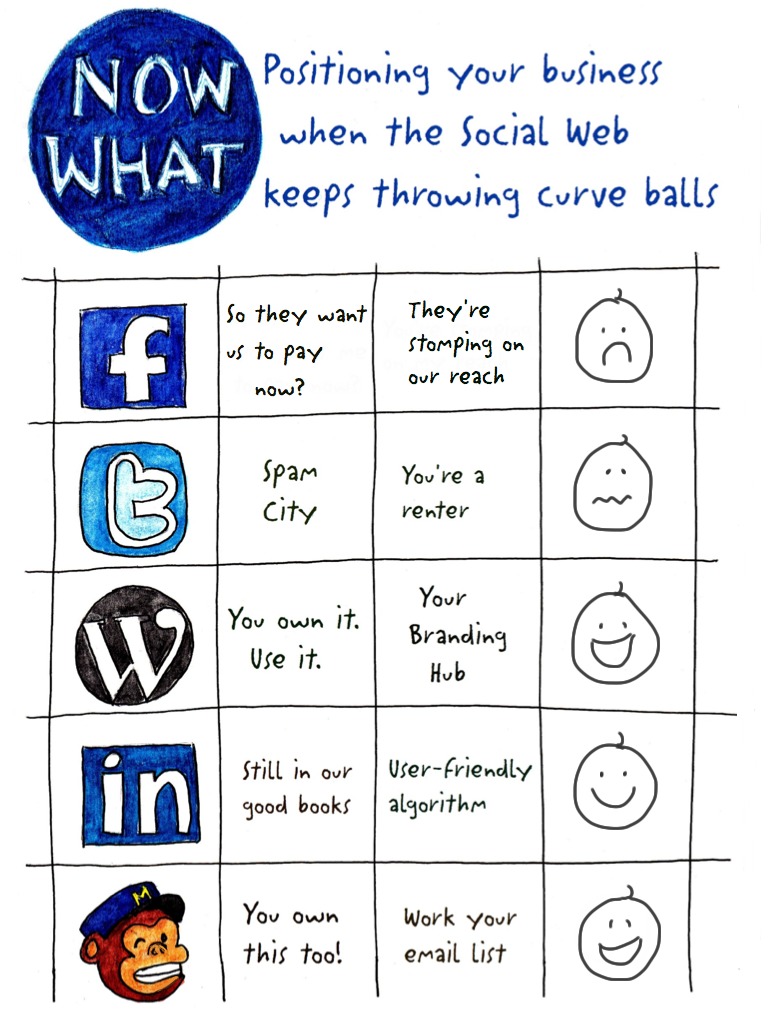
The workshop is 3 hours for the low price of $100 (Plus 13% HST), and includes a helpful handout and coffee and tea service.
The workshop is designed for independent entrepreneurs who want tips on how to market their products/services/specialities on the Social Web.
I profile five business, including my own, and show how each business owner has had to figure out which platforms best help them reach their goals. For some, it’s WordPress. For others it’s Twitter. Many female entrepreneurs swear by Pinterest, calling it “solid gold.” Recent algorithm changes, however, have thrown a curve ball on many people’s marketing strategies. I’ll address this too.
If you want the latest on Twitter, Facebook, Pinterst, Instagram, WordPress, and LinkedIn, I hope you’ll join me.
See you in class!
![]()
June 3, 2014
The #YesAllWomen hashtag has inspired a ton of stories by women describing what they experience on a daily basis just because they are women. For this, I go back to John Berger and an earlier post I wrote called, “Out of sight.” Here is the podcast. Have a listen:
![Left: Steve McQueen in The Thomas Crown Affair, 1968. Photo Credit: [ United Artists / The Kobal Collection ]. Right: Marilyn Monroe Reading, Long Island. Photo: Eve Arnold.](https://alisongarwoodjones.com/wp-content/uploads/2014/06/Steve-Marilyn.jpg) Left: Steve McQueen in The Thomas Crown Affair, 1968. Photo Credit: United Artists / The Kobal Collection. Right: Marilyn Monroe Reading, Long Island. Photo Credit: Eve Arnold.
Left: Steve McQueen in The Thomas Crown Affair, 1968. Photo Credit: United Artists / The Kobal Collection. Right: Marilyn Monroe Reading, Long Island. Photo Credit: Eve Arnold.May 30, 2014
At first we were told to study French.
And so we did,
Memorizing hundreds of verbs:
To resemble, to be like, to look like.
To loosen, to unleash, to let go.
To daze, to stun, to bewilder …
And when school was done with us, we found jobs in government.
Or moved to Montréal to become servers.
Most of us never bothered with it again, except …
Knowing even a little French was a source of smug satisfaction.
Especially in places like The Louvre Gift Shop:
“C’est un cadeau pour ma mère.”
Or the BNP line:
“Pardonez-moi, je suis venu ici en premier.”
Or on boulevards at insistent businessmen:
“Va te faire foutre, Ass Hole.”
That told them.
Some of us added German and Italian to the mix.
But then we were told, “Nope, now it’s Chinese.”
现在 我需要知道中国
Tutors held us hostage for hours learning this language.
Our Twizzler consumption tripled.
We started to wonder whatever happened to Esperanto?
All those plans to foster world peace and international understanding?
This was right at the time we were saving the Whooping Crane.
Naturally, that moment passed and was replaced by another,
With brand new rules.
The Whooping Crane survived.
And from the head of Zeus sprung Code,
The new global language.
Our stress over the past perfect seemed so silly now.
So neoclassical.
HTML tables drowned out verb charts, periodic tables,
Powdered wigs and harpsichord scales.
Border collapses, vertical alignments, global attributes.
Amo, Amas, Amat.
Be bold.
That’s easy today: <strong>Take that</strong>
Colourful. Are you kidding me: <span style=“color: #ff0000;“>I’ve got plenty</span>
Ignore said punctuation at your peril.
Practice it for 14 hours a day — at least.
And don’t expect to get the girl.
Wait! Invent an algorithm to see if she’s single.
Come up with the best combinatorics, graph theory and string analysis.
Watch out for the Russians and Chinese.
Don’t sleep.
Don’t change your underwear.
Just win.
Then collapse with some beer, pizza and porn.
But wait …
If your idea of language is something other.
If bold to you is Angelou and Mandela,
And search is Odysseus, not Google,
Be prepared to justify yourself to the Arbiters of Now.
Steel yourself for a life of economic poverty.
Or learn to speak their language in exchange for food,
And come home at sunset
To shelves stuffed with gold and folded roadmaps to Byzantium.
Embrace compromise, but bookend each day with riches.
</span><span style=”line-height: 1.5em;”>Not the end.</span>